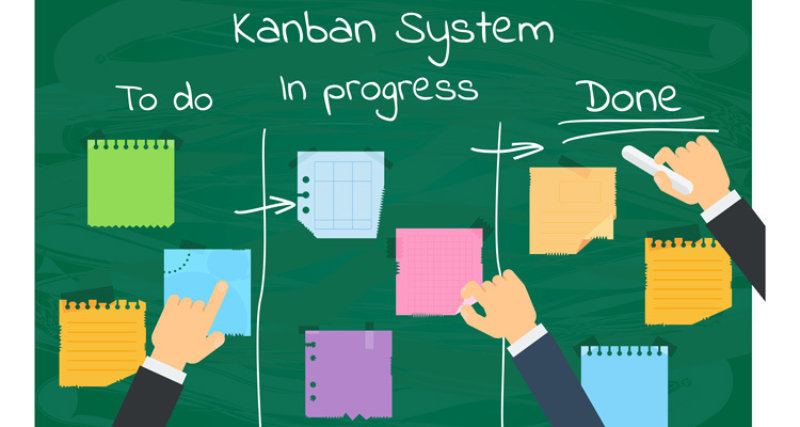
In our last post, we mentioned there were four tenets needed when designing a basic Kanban system. We also touched on the first two tenets and how to apply them in IT Operations.
For those who don’t remember, the four tenets of Kanban are:
- Making the work visible.
- Limiting the work in progress.
- Measuring and improving the progress of your work.
- Communicating the work state.
In this post, we’re going to look at the final two tenets and how they’re applied into a basic Kanban system. This will help you and your IT Operations become better equipped to reduce constraints and maximize collaboration, so that projects run smoothly from start to finish.
TENET 3: MEASURING AND IMPROVING THE PROGRESS OF YOUR WORK
The whole purpose of implementing a Kanban system is to improve the way projects are managed within your organization. But positive change doesn’t happen overnight. Success is achieved when progress is measured and adjusted accordingly, so that tasks move smoothly down the production queue.
Remember the Theory of Constraints? It’s the idea that your team is only as effective as the weakest element in the system. Well, no matter how effective you are at managing projects, you’re going to run into bottlenecks at some point. Constraints can be anything, from a struggling teammate to a miscalculation of resources and capacity, or even a glitch in your IT system. The good news is that Kanban makes it easy to pinpoint these constraints, so that you can address them and teach teammates how to avoid similar bottlenecks in the future.
In other words, bottlenecks are part of progress, provided they’re addressed accordingly. This brings us to tenet three, measuring progress.
Progress should be measured as a journey filled with various stages between its start and finish point. As we’ve mentioned, there are going to be road bumps along this journey, so focusing solely on how fast tasks are being completed is a recipe for failure. Instead, when measuring the progress of your project, ask yourself the following questions:
1.What’s the arrival rate of our work compared to the closure rate? This shows whether teams are able to keep up with demand. With the help of Cumulative Flow Diagrams (CFDs), you can see whether your team has the capacity to keep up with new scheduled and unscheduled projects, in addition to measuring the amount of work in progress (WIP) in your workflow. This is important for preventing overwhelm and accurately measuring capacity.
2.How long does it take for work to get completed? Whether you’re measuring success or looking at bottlenecks in your workflow, you need to know the time it takes for work to be completed from start to finish. You can measure this in histograms by looking at Lead Time and Cycle Time. Lead Time looks at the amount of time it takes for a project to be completed, from the minute it was assigned, and Cycle Time gives you the amount of time it takes to finish a task once that task has actually begun. Both are useful for estimating when teams will meet deadlines, but Cycle Time is more accurate for forecasting because it doesn’t factor in downtime. There’s also the Mean Time to Repair (MTTR), which looks at how long it takes to repair a failed component in your workflow.
3.Where is the work getting stuck? Perfect for identifying bottlenecks, Lead Time gives you deeper insight into which tasks are taking unusually long to complete. From there, you can identify what’s been sitting in the backlog and what’s been inactive for an extended period of time. Armed with this information, you’re able to come up with an action plan that addresses any bottlenecks that exist in your workflow, so you can resume productivity at optimal speed.
As you can see, progress is more complex than simply reaching the finish line. Looking at these three elements doesn’t only give you a better understanding of the progress your team is making, it also helps you address issues and empower workers so that you’re more likely to meet your objectives within your agreed-upon timeframe.
TENET 4: COMMUNICATING THE WORK STATE
Nothing will prevent effective collaboration quicker than departmental silos. When teams work independently, with their own goals and objectives without thinking about how their project affects the organization as a whole, friction inevitably arises. And the easiest way to slip into the silo mentality is to stop communicating with other departments.
Just how dangerous are departmental silos? Consider this scenario: The developer team at a software company is working on an update for their most popular mobile application, which 50% of customers use because it can be synced up with their desktop computer at home. At the same time, the IT Operations team is working on a security patch for its desktop application that addresses recent vulnerabilities. Since the two teams aren’t working together, they end up eliminating the compatibility between mobile and desktop applications. Unable to sync data across their devices since the latest update, customers are now upset at the recent patch—and the organization now has to work around the clock to repair the problem in a timely manner.
Both teams are working on their own projects, thinking about their own IT roadmaps. Neither considered how their project might affect the company as a whole, and their actions could bring the company bad publicity and even affect its potential earnings. But how do we tear down silos and prevent this scenario from becoming the norm?
The key to effective collaboration is good communication.
Whenever teams undertake a project, it’s important to communicate with other departments and see whether it’s possible to adopt a cross-departmental approach. After all, every department has an area of expertise that can bring value to your project. This is especially true for IT Operations teams, as the flexible and versatile nature of their work has them tackling a number of different tasks that directly impact multiple departments within an organization.
Fortunately, Kanban makes it easy to keep an open channel of communication between IT Operations and other departments within your organization. Not only do digital Kanban boards make it easy to see what projects other departments are working on, your software solution should also come with built-in collaboration tools that promote cross-team communication. That way, stakeholders, department managers, and executives can always stay informed about the direction of projects within their organization. And that’s how you prevent departmental silos from forming.
PUTTING TOGETHER A BASIC KANBAN SYSTEM IS A PIECE OF CAKE
Designing a basic Kanban system is easier than you think, and when everyone within your organization adopts the Kanban approach, you’ll begin to notice a much smoother workflow. Kanban helps IT Operations teams collaborate with other departments, so everyone is working toward the same set of goals and objectives.
Ready to learn more about Kanban and how you can use it to transform the way IT Operations teams manage work? Download our eBook “Using Kanban for IT Operations” to see just how effective it is at helping operations teams manage their time and capacity more effectively. If you are interested in digital Kanban, check out Planview AgilePlace and sign up for a free trial.
![A Global Collaborative Work Management Blueprint [Video]](https://blog.planview.com/wp-content/uploads/2019/07/A-Global-Collaborative-Work-management-blueprint.png)


